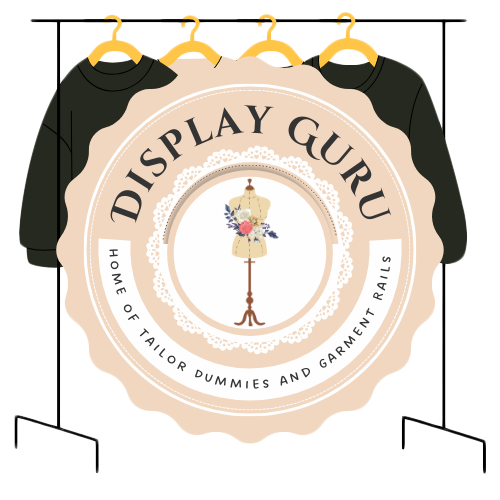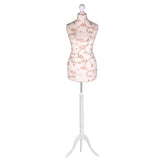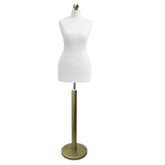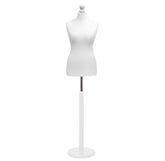The Ultimate Guide to Hat Stands Display
A hat stand is much more than just a place to hang your hat; it’s an essential tool for both preservation and presentation. The right stand does two jobs at once: it carefully maintains a hat's shape, preventing damage, and it turns a personal collection or shop inventory into an eye-catching display. It's part guardian, part gallery.
Understanding The Purpose Of A Hat Stand Display
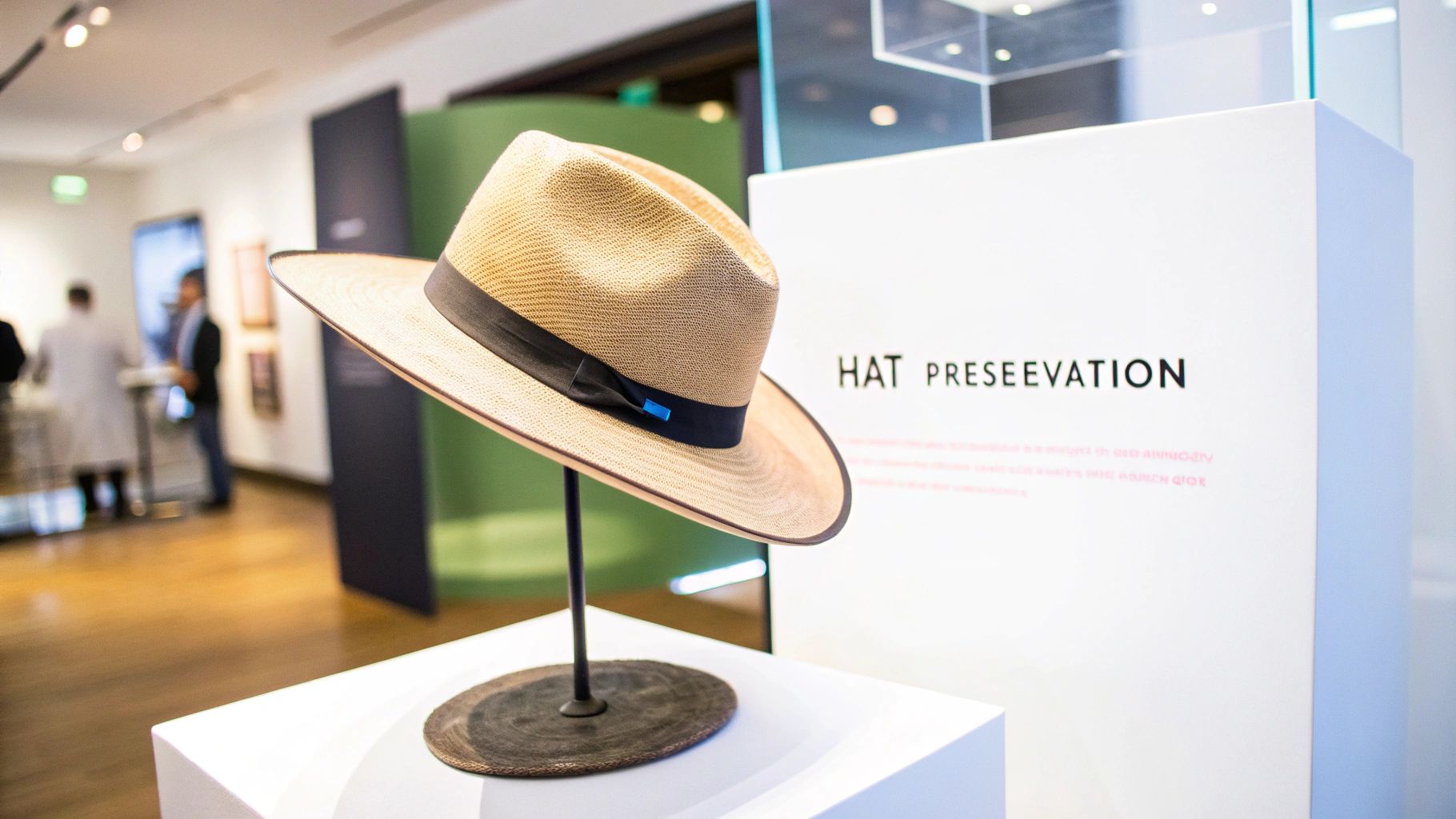
It helps to think of a hat stand like a frame for a painting. While the art is the main event, the frame protects its edges and presents it in the best possible light. A good hat stand does the same for your headwear, safeguarding your investment and boosting its visual appeal, whether it’s for a single treasured fedora at home or a whole shop floor of new stock.
This balance of function and form is precisely why choosing the right one matters so much. Its most important job is practical. Hats, especially those crafted from felt, straw, or other structured materials, can easily lose their shape if stored carelessly. Piling them on a shelf or squashing them in a wardrobe can cause permanent creases and warped brims, ruining the silhouette.
A proper hat stand supports the crown from the inside, almost like a mannequin head. This holds the hat’s original form, just as the maker intended, making sure it’s always ready to wear and looking its best.
From Personal Collections To Retail Success
The role of a hat stand really shines in two key areas: for personal collectors at home and for commercial use in shops. The core goals are the same—preservation and presentation—but the priorities differ slightly.
For the home enthusiast, a few well-chosen stands can turn a collection into a part of your decor. It’s a brilliant way to organise your favourite hats, keeping them within reach while making them a stylish feature of the room. Your hats are no longer hidden away; they're on display.
In a retail setting, the stakes are even higher. Good visual merchandising is proven to attract customers and increase sales, and hat stands are a key part of that. A strategic display can:
- Spotlight Star Products: A single, elegant stand can immediately draw the eye to a high-end or new-season hat.
- Build Visual Interest: Mixing stands of different heights and materials stops a display from looking monotonous.
- Tell a Story: Grouping hats by style, season, or occasion helps customers imagine themselves wearing them.
In the end, whether you’re a passionate collector or a shop owner, the goal is the same: to give the hat the respect it deserves. To see how different stands can be used in a commercial space, it's worth exploring the principles of effective retail display stands. Choosing well ensures your headwear stays in perfect shape and is shown with the elegance it warrants.
The Evolution of Hat Display in British Culture
To really get a feel for the modern hat display stand, it helps to trace its roots back through British history. It’s a journey that reveals how this seemingly simple item has always been a mirror, reflecting the fashions, social rules, and interior styles of the day. The story, funnily enough, doesn't start in a shop, but in the hallways of British homes.
Back in the Victorian and Edwardian eras, a hat wasn't just an accessory; it was an essential part of anyone’s daily outfit and a clear sign of their social standing. Naturally, every home needed a proper place to keep hats for the family and for guests. This is where the classic hall hatstand made its grand entrance.
These weren't subtle pieces of furniture. In the UK, the hatstand was a household staple, often towering at least 150 cm (5 feet) high. Typically crafted from dark, polished wood or ornate cast iron, they were built to impress. A strong central pole, a wide, sturdy base, and an array of hooks made them perfect for holding the tall top hats and elaborate bonnets of the time. You can read more about their role in Victorian and Edwardian interiors on Wikipedia.
From the Hallway to the High Street
As the calendar turned from the 19th to the 20th century, a subtle but important shift began. The domestic hall stand was still a common sight, but a new kind of hat display started popping up in the exciting new world of retail. The rise of dedicated millinery shops and grand department stores created a demand for something more specialised.
These new stands weren't just for storage; they were for selling. Their job was to present a single hat as an object of pure desire. Boutiques in the early 1900s used stands that lifted the hat, showcasing it with a focused elegance that made it feel special. The design of the stand was now intrinsically linked to the fashion it was there to sell.
Think of the Roaring Twenties. The cloche hat—a snug, bell-shaped design—was all the rage. To show it off properly, milliners turned to sleek, elegant stands, often made from chrome or slender, turned wood. These stands featured a smaller, rounded top that supported the cloche's unique shape perfectly without stretching or distorting it, showing the customer exactly how it would sit.
The design of a hat stand has always been a conversation with the fashion of its time. A tall, robust Victorian stand was built for top hats and heavy coats, while a delicate Art Deco stand was crafted to complement the streamlined elegance of a 1920s cloche.
Mid-Century Modernism and Beyond
The mid-20th century ushered in yet another wave of change. The modernist movement influenced everything from architecture to furniture, and the humble hat display stand was swept along with it. The heavy, ornate styles of the past gave way to a much cleaner, minimalist aesthetic.
- Clean Lines: Materials like teak and bentwood took centre stage, celebrated for their simple, organic shapes.
- Function Over Form: While still stylish, the new philosophy prioritised practicality and an uncluttered look.
- Abstract Forms: Mannequin heads became more abstract and stylised, leaving behind realistic features for simple, sculptural shapes that let the hat do all the talking.
This was the era when the hat started to transition from a daily necessity to more of a fashion statement. As a result, the displays themselves became more creative and artistic. A well-designed hat stand from this period was a piece of sculpture in its own right, designed to blend seamlessly into a modern home or a chic boutique.
Today, we see a wonderful mix of all these historical influences. You can find minimalist metal stands with an Art Deco echo, rustic wooden ones that hark back to Victorian craftsmanship, and abstract head forms born from mid-century modernism. Understanding this evolution gives the simple act of choosing a hat stand a bit more depth. It’s not just about finding a place to put your hat; it’s about connecting with a long and fascinating legacy of style, culture, and design.
Exploring Different Types Of Hat Stands
Choosing the right hat stand is a bit like picking the perfect frame for a piece of art. It all comes down to the hat itself and the space you have to show it off. You wouldn't put a tiny painting in a massive, ornate frame, and the same logic applies here—a towering floor stand for a single, delicate fascinator just wouldn't look right.
The good news is that the world of hat stands is wonderfully varied, with each type designed to solve a specific display challenge. Getting to grips with the main categories is the first step to creating an arrangement that’s both practical and stylish. Let’s break down the four main groups to see what might work best for you.
Countertop Hat Stands
Think of countertop stands as the individual spotlights of the hat display world. They're compact, usually designed to hold a single hat, and are perfect for sitting on a table, shelf, or checkout counter. Their whole purpose is to elevate one special piece and grab someone's attention.
In a shop, they're essential for highlighting a new arrival or a best-seller. At home, they’re a fantastic way to turn a favourite hat into a decorative feature on a dressing table. Most have a simple pole with a domed top, which is crucial for supporting the hat's crown and keeping its shape immaculate.
Floor Standing Hat Racks
If countertop stands are the spotlights, then floor-standing racks are the full stage production. These are much larger, free-standing pieces of furniture designed to hold multiple hats, often with extra space for coats and scarves. They're basically the modern-day version of the classic Victorian hall stand, built for serious capacity.
A floor-standing hat stand is a brilliant choice for an entryway or a spacious dressing room, creating a central hub for all your outerwear. For a retailer, one of these can instantly create a dedicated "hat department," inviting customers to browse an entire collection. Their height also adds a lovely vertical element to a room, drawing the eye upwards.
Wall-Mounted Hat Displays
When you're short on floor space, wall-mounted racks are an ingenious solution. By fixing your display directly to the wall, you can transform an empty vertical surface into stylish and practical storage. This approach is a lifesaver in smaller rooms, narrow hallways, or for anyone wanting to create a dramatic "hat wall."
These options range from simple, individual pegs to more elaborate shelving systems that can hold a whole collection. They're especially popular with serious collectors who want to show off their hats without cluttering up the room. For a really cohesive look, you can pair them with other display stands for clothing that complement a wall-mounted setup.
By taking your collection vertical, you not only save valuable floor space but also create a dynamic visual element. A well-organised wall display can become a focal point of a room, showcasing your hats like a gallery installation.
The infographic below offers a quick comparison of these three primary types, highlighting their best uses and typical capacities.
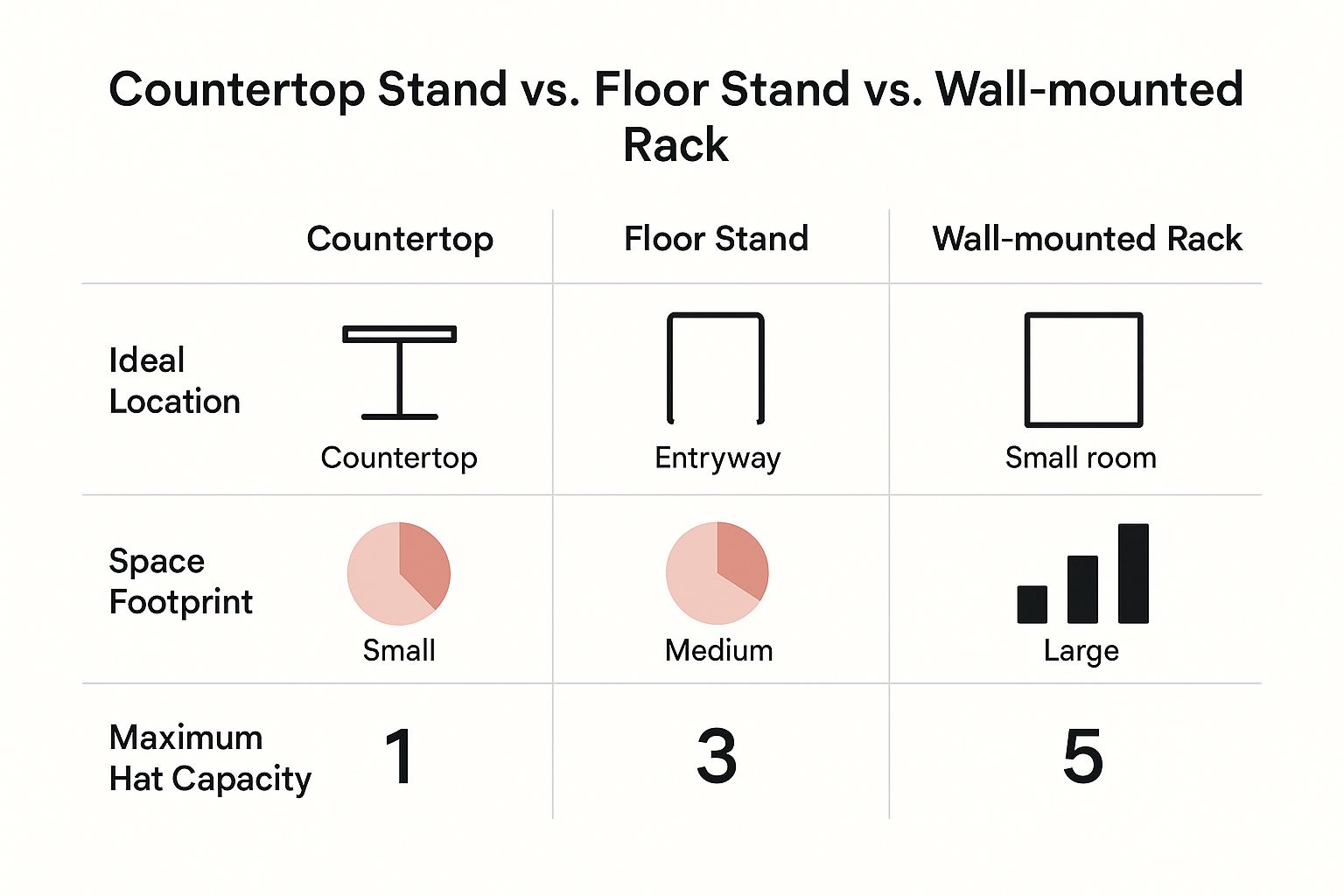
As you can see, each type is really optimised for a different environment, from the focused countertop model to the space-saving wall rack.
Mannequin And Abstract Head Displays
Finally, we have the most realistic option: mannequin heads. These come in all sorts of forms, from hyper-realistic heads with detailed facial features to more minimalist, abstract sculptures. Their huge advantage is showing people exactly how a hat will sit when it’s actually being worn.
This is particularly useful for styles that need a specific fit or angle, like cloches, berets, or asymmetrical designs. Abstract heads, often finished in soft velvet or neutral tones, give off a sophisticated, high-fashion vibe without distracting from the hat itself. These have a long and storied history in retail; specialist millinery stands were a common sight in UK boutiques from the 1920s onwards, using elegant wooden or chrome forms to perfectly present the hats of the day.
To help you weigh the options, here is a quick breakdown of the main stand types and what they do best.
Comparison Of Hat Stand Display Types
| Stand Type | Ideal Use Case | Common Materials | Primary Advantage |
|---|---|---|---|
| Countertop Stand | Highlighting a single hat on a shelf or till | Metal, Wood, Acrylic | Focuses attention on a specific item |
| Floor Standing Rack | Storing multiple hats, coats, and scarves | Metal, Wood | High capacity and creates a focal point |
| Wall-Mounted Display | Saving floor space; creating a feature wall | Wood, Metal, Plastic | Space-efficient and highly customisable |
| Mannequin/Abstract Head | Showing how a hat looks when worn | Fibreglass, Velvet, Plastic | Provides a realistic, in-context view |
Each style offers a unique way to present your hats, so the right choice really depends on your collection, your space, and the story you want to tell.
Choosing The Right Material For Your Display
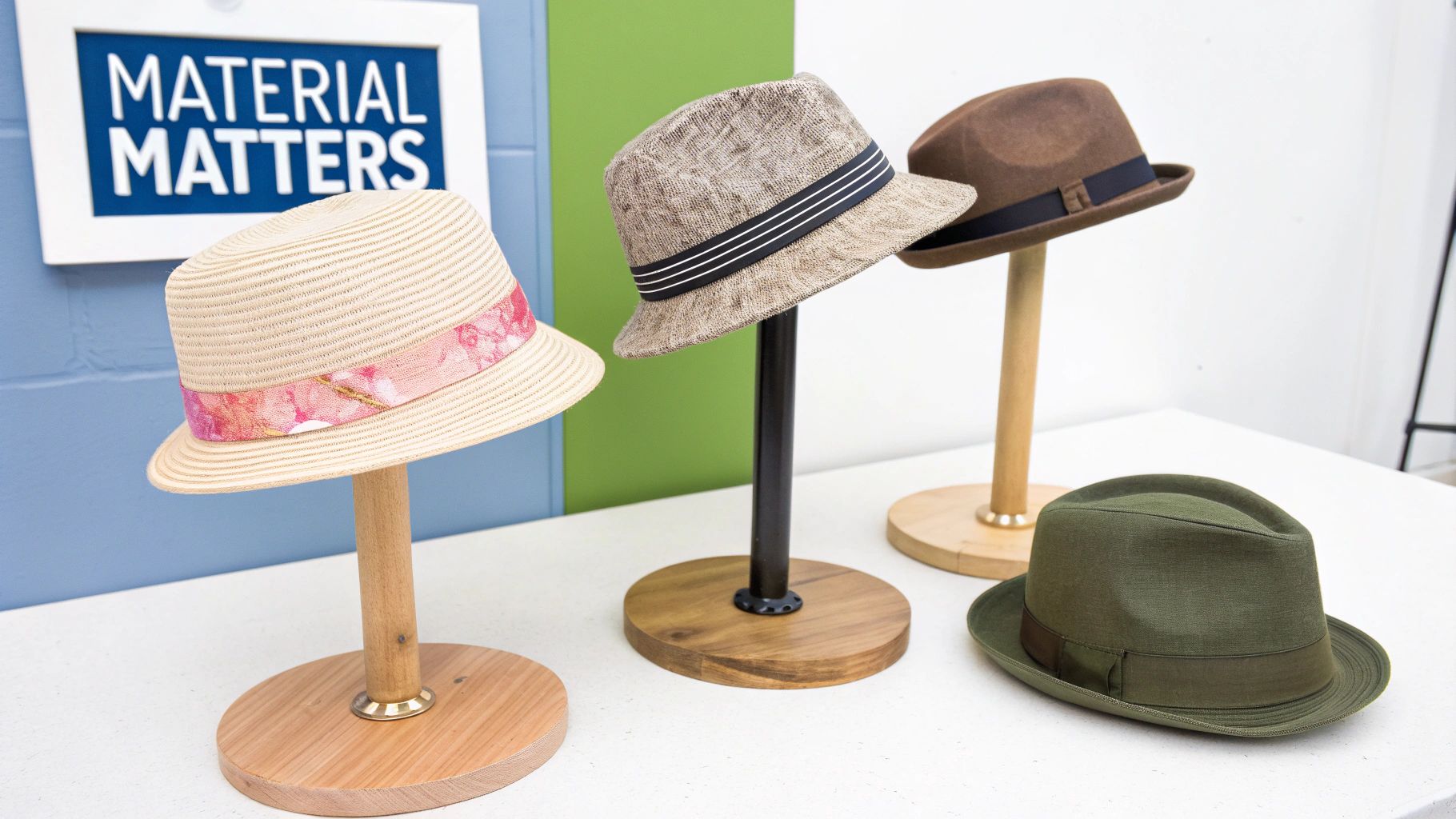
Picking the right material for a hat stands display is a bit like choosing the perfect frame for a piece of art. The material isn't just there to hold the hat; it’s there to complement its style, communicate a certain feeling, and most importantly, keep it safe. It’s a delicate balance between appearance, longevity, and the practical needs of your hat collection.
Every material tells its own story. A classic wooden stand can bring a sense of warmth and heritage to a room, whereas a sleek metal one might create a more modern, industrial vibe. This decision has a real impact, not just on the look of your display but also on the long-term health of your headwear.
Classic And Timeless Wood
Wood is a perennial favourite, and for good reason. It has a natural, inviting quality that fits beautifully with almost any interior, from rustic farmhouse to a more traditional, refined study. Oak, walnut, and pine are popular choices, and each brings its own unique character through its grain and colour.
One of wood's biggest draws is its sturdy, reliable nature. When you're weighing your options, getting some background on choosing wooden materials for furniture can really help you understand what makes for a durable and well-finished piece. A solid, well-made wooden stand provides great stability, so you know your hats are secure.
But perhaps the most important benefit is how gentle it is. A smooth, polished wooden dome won't snag or damage delicate fabrics, making it a safe bet for everything from your best felt fedora to a breezy straw boater.
Sleek And Sturdy Metal
If you’re aiming for a more contemporary or minimalist aesthetic, metal stands are a fantastic choice. Materials like steel, chrome, and wrought iron offer clean lines and an industrial edge that can make a real statement. Their profiles are often slimmer than wood, which helps create a more open, airy feel in a display.
Metal’s main advantage is its incredible durability and stability. A weighted metal base creates a low centre of gravity, making these stands incredibly difficult to tip over. That’s a massive plus in a busy shop or a home with kids and pets running about.
- Chrome: Gives you a bright, reflective finish for a clean, high-end feel.
- Wrought Iron: Offers a classic, sometimes ornate look that evokes traditional craftsmanship.
- Powder-Coated Steel: Delivers a minimalist, matte finish that comes in a variety of colours.
This inherent strength makes metal a smart, long-lasting investment for any hat display.
Modern And Minimalist Acrylic
Acrylic, or Perspex, stands offer a modern and almost invisible way to show off your hats. Because they're completely transparent, all the attention stays on the hat itself. This makes them a brilliant choice for headwear that's vibrant, intricately detailed, or features a bold colour palette.
These stands are also incredibly light, so they’re easy to move and rearrange whenever you fancy a change in your shop layout or home display. They work especially well in smaller spaces or on crowded surfaces, as their clear nature stops the area from feeling cluttered.
The beauty of an acrylic stand is its subtlety. It creates the illusion that the hat is floating, allowing every detail of the design to be appreciated without distraction from the stand itself.
Soft And Protective Fabric
When it comes to the absolute best care for your hats, nothing beats a fabric-covered stand. These displays, usually with a padded form wrapped in materials like velvet, linen, or canvas, are designed with one thing in mind: preservation.
The soft surface is exceptionally gentle, preventing any indentations or pressure marks on delicate materials like silk, fine felt, or precious vintage fabrics. The texture of velvet also provides a subtle grip, helping to keep hats perfectly in place without any risk of them slipping. This is why they are the professional’s go-to for valuable or antique headwear.
These principles of protection apply to other garments, too. You can see how fabric is used to preserve shape by looking at a professional dress form stand. Opting for a fabric-covered stand is the surest way to give your most treasured hats the five-star treatment they deserve.
How To Style And Arrange Your Hat Collection
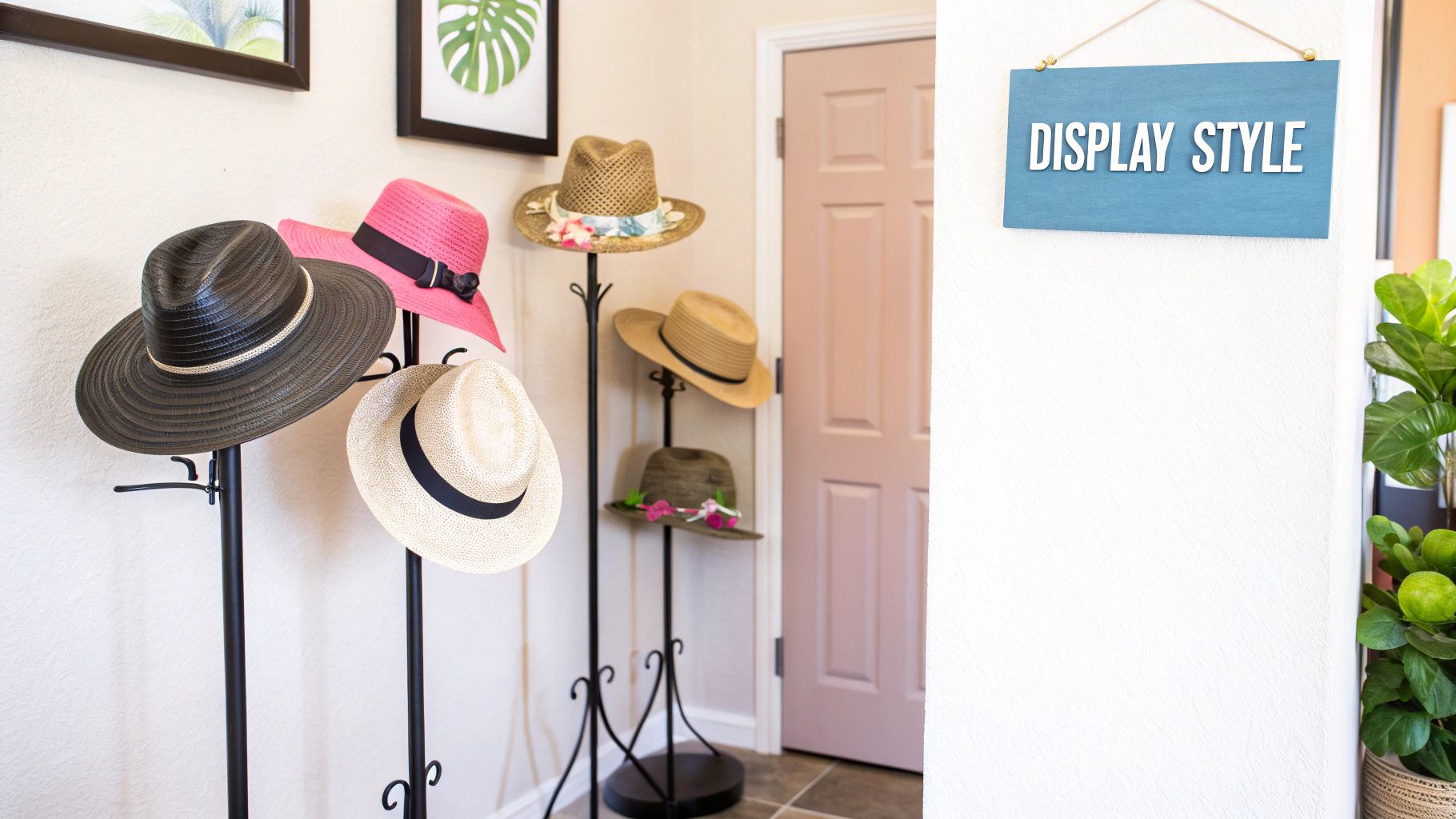
So, you’ve picked out the perfect hat stands display. Now for the fun part: transforming it from simple storage into a curated exhibition. Good arrangement is about more than just being tidy; it’s a chance to tell a story with your collection. Whether it's for your home or a retail space, a well-styled display can turn heads and inject personality into any room.
The secret is to think like a visual merchandiser. You'll need to consider balance, colour, height, and theme to build an arrangement that looks fantastic and works well. A thoughtful display doesn't just hold hats—it celebrates them.
Create Visual Harmony And Interest
One of the best ways to create a cohesive look is to group your hats thematically. It makes the entire display much easier on the eye and allows people to take it all in. There are a few clever ways to do this.
- Group by Colour: You could arrange hats in a gradient, from light to dark, or put similar shades together. This creates a really organised, almost rainbow-like effect that’s incredibly satisfying to look at.
- Group by Style: Put all your fedoras in one spot, cluster your berets, or create a dedicated section for those wide-brimmed sun hats. This method really highlights the subtle differences between similar designs.
- Group by Season: This is a very practical approach, especially for personal collections. It keeps your current hats within easy reach while the off-season ones are neatly stored.
Beyond just grouping, playing with the heights of your display stands is absolutely crucial. If you place stands of different sizes next to each other, you create a dynamic, multi-level landscape. This simple trick stops the display from looking flat and monotonous, adding a sense of depth and rhythm that makes the whole thing much more engaging.
A great hat display tells a story through thoughtful arrangement. By grouping similar styles or colours and playing with varying heights, you guide the viewer's eye and transform a simple collection into a compelling visual narrative.
Integrate Your Display With Room Decor
For a truly polished finish, your hat display needs to feel like an intentional part of the room's design, not just something you added later. This really just means matching the style of your stands to your existing furniture and decor. A rustic wooden stand, for example, will feel right at home in a room with a farmhouse vibe, while a sleek chrome stand will beautifully complement a modern, minimalist space.
As you plan where everything will go, modern tools can offer some fresh ideas on how your collection fits into the wider room design. For example, it's becoming more common to see people utilizing virtual staging tools for display arrangement to picture different layouts before moving a single thing. You could create a "feature wall" with wall-mounted stands to turn your hats into a focal piece of art, or use a single, sculptural stand as a statement piece on a console table.
Strategic Arrangements For Retail Success
In a shop, a hat display has to do more than just look good—it has to sell. The UK headwear market brought in around USD 546.6 million in revenue back in 2022, and that number is expected to grow. In such a competitive field, getting your merchandising right is critical.
Your displays should be used to guide how customers move through the space. Place eye-catching stands with new arrivals right near the entrance to draw people in. Create "hero" displays on countertops to shine a spotlight on your premium or best-selling hats. By arranging your hat stands strategically, you can influence the customer's journey, highlight key products, and ultimately boost sales. For a deeper dive into these tactics, our guide to visual merchandising guidelines has some brilliant tips for retailers.
Got Questions About Hat Stands? We’ve Got Answers.
When it comes to displaying your hats, a few common questions always seem to pop up. How do you keep the stands clean? Will they stretch your favourite fedora? How on earth do you pick the right size?
Let's clear things up. Getting these details right from the start is the key to keeping your headwear in pristine condition for years, whether you're a long-time collector or just starting out.
How Do I Clean My Hat Stand?
The secret to cleaning your stand is simple: match the method to the material. A one-size-fits-all approach can lead to damage, so it pays to be specific. Most of the time, a light touch is all you’ll need.
Here’s a quick breakdown for different materials:
- Wooden Stands: A regular dusting with a soft, dry microfibre cloth will do the trick. For a deeper clean, you can slightly dampen the cloth with water and a drop of mild soap, but be sure to wipe it completely dry straight away to avoid any moisture damage.
- Metal Stands: Usually, a quick wipe with a dry cloth is enough. If you’ve got fingerprints on a polished chrome finish, spray a little glass cleaner onto your cloth (never directly onto the metal) and buff it to a brilliant shine.
- Acrylic Stands: These are prone to scratching, so stick to a soft microfibre cloth. A cloth lightly dampened with just water is perfect for removing dust and smudges. Definitely avoid harsh chemical cleaners.
- Fabric-Covered Stands: A lint roller is your best friend here. You can also use the brush attachment on your vacuum for a gentle clean. If you spot a small mark, test a tiny amount of fabric cleaner on an inconspicuous area first before carefully spot-cleaning with a damp cloth.
Will A Hat Stand Stretch Or Damage My Hat?
This is a great question, and a common worry. The short answer is no—a correctly sized stand will not damage your hat. The trick is to make sure the dome of the stand is just a fraction smaller than the hat's crown. This lets the hat sit comfortably without being stretched out of shape.
You only run into trouble when the stand is too big. This forces the material to expand, which can permanently ruin felt or straw hats over time.
A hat stand should support, not strain. Think of it as a gentle cradle for the crown, holding the hat’s intended shape without exerting any outward pressure. The goal is preservation, not distortion.
On the other hand, a stand that’s too small won’t give enough support, which can lead to sagging or creasing. You’re looking for that perfect, snug-but-gentle fit.
How Do I Choose The Right Size Stand For My Hat?
Picking the right size is crucial, and it’s not as simple as it sounds. A fedora with its deep crown has completely different needs to a flat-topped boater.
The most important thing to look at is the circumference and shape of the stand's dome. It needs to mirror the inside of your hat’s crown as closely as possible, without being too large.
Sizing Stands For Specific Hat Types
Let's break it down by style:
- Fedoras and Trilbies: These classics have a very defined crown, often with a "pinch" at the front. You’ll want a stand with an oval-shaped dome that fits neatly inside, supporting the shape without pushing it out.
- Wide-Brimmed Sun Hats: Here, the job is to support the crown and stop the brim from drooping. A standard dome-topped stand is ideal, as long as it’s tall enough to let the brim hang freely without resting on the shelf or table.
- Beanies and Soft Hats: They might not have a rigid structure, but they can easily get squashed in a drawer. A simple mannequin head or a small, rounded countertop stand is perfect for keeping their general shape.
- Berets and Flat Caps: These look best on a flatter, almost mushroom-shaped stand or a mannequin head. This helps fill out the body of the cap and shows off its intended drape.
For a really versatile option, you can't go wrong with mannequin heads, as they show exactly how a hat is meant to be worn. The same principles that apply to hats also apply to other headwear, as we cover in our guide on using mannequin heads for wigs. It’s all about providing a realistic and supportive base.
By keeping these points in mind, you can choose and use your hat stands display with total confidence. The right stand isn't just for show; it’s a guardian for your collection, preserving the shape, quality, and character of every piece.
At Display Guru, we provide a wide range of high-quality display solutions to help you showcase your collection with style and confidence. Explore our products today at https://www.displayguru.co.uk.
